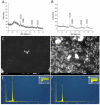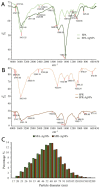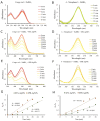Biosynthesis of Silver Nanoparticles Using Salvia pratensis L. Aerial Part and Root Extracts: Bioactivity, Biocompatibility, and Catalytic Potential
- PMID: 36771054
- PMCID: PMC9921037
- DOI: 10.3390/molecules28031387
Biosynthesis of Silver Nanoparticles Using Salvia pratensis L. Aerial Part and Root Extracts: Bioactivity, Biocompatibility, and Catalytic Potential
Abstract
The aim of this research was the synthesis of silver nanoparticles (SPA- and SPR-AgNPs) using the aqueous extracts of the aerial (SPA) and the root (SPR) parts of the plant Salvia pratensis L., their characterization, reaction condition optimization, and evaluation of their biological and catalytic activity. UV-Vis spectroscopy, X-ray powder diffraction (XRPD), scanning electron microscopy with EDS analysis (SEM/EDS), and dynamic light scattering (DLS) analysis were utilized to characterize the nanoparticles, while Fourier transform infrared (FTIR) spectroscopy was used to detect some functional groups of compounds present in the plant extracts and nanoparticles. The phenolic and flavonoid contents, as well as the antioxidant activity of the extracts, were determined spectrophotometrically. The synthesized nanoparticles showed twice-higher activity in neutralizing 2,2'-azino-bis(3-ethylbenzothiazoline-6-sulfonic acid) (ABTS+) compared with the respective extracts. SPR-AgNPs exhibited strong antimicrobial activity against almost all of the tested bacteria (<0.0039 mg/mL) and fungal strains, especially against the genus Penicillium (<0.0391 mg/mL). Moreover, they were fully biocompatible on all the tested eukaryotic cells, while the hemolysis of erythrocytes was not observed at the highest tested concentration of 150 µg/mL. The catalytic activity of nanoparticles toward Congo Red and 4-nitrophenol was also demonstrated. The obtained results confirm the possibility of the safe application of the synthesized nanoparticles in medicine and as a catalyst in various processes.
Keywords: Salvia pratensis L.; antimicrobial activity; antioxidant activity; catalysts; hemolytic activity; silver nanoparticles.
Conflict of interest statement
The authors declare no conflict of interest.
Figures







Similar articles
-
Green Synthesis of Silver Nanoparticles Using Salvia verticillata and Filipendula ulmaria Extracts: Optimization of Synthesis, Biological Activities, and Catalytic Properties.Molecules. 2023 Jan 13;28(2):808. doi: 10.3390/molecules28020808. Molecules. 2023. PMID: 36677866 Free PMC article.
-
Application potential of biogenically synthesized silver nanoparticles using Lythrum salicaria L. extracts as pharmaceuticals and catalysts for organic pollutant degradation.RSC Adv. 2021 Nov 3;11(56):35585-35599. doi: 10.1039/d1ra05570d. eCollection 2021 Oct 28. RSC Adv. 2021. PMID: 35493140 Free PMC article.
-
Exploiting fruit byproducts for eco-friendly nanosynthesis: Citrus × clementina peel extract mediated fabrication of silver nanoparticles with high efficacy against microbial pathogens and rat glial tumor C6 cells.Environ Sci Pollut Res Int. 2018 Apr;25(11):10250-10263. doi: 10.1007/s11356-017-8724-z. Epub 2017 Mar 17. Environ Sci Pollut Res Int. 2018. PMID: 28303540
-
Phytosynthesis of silver nanoparticles using Artemisia marschalliana Sprengel aerial part extract and assessment of their antioxidant, anticancer, and antibacterial properties.Int J Nanomedicine. 2016 Apr 29;11:1835-46. doi: 10.2147/IJN.S99882. eCollection 2016. Int J Nanomedicine. 2016. PMID: 27199558 Free PMC article.
-
Review green synthesis of silver nanoparticles by using plant extracts and their antimicrobial activity.Saudi J Biol Sci. 2024 Jan;31(1):103877. doi: 10.1016/j.sjbs.2023.103877. Epub 2023 Nov 26. Saudi J Biol Sci. 2024. PMID: 38148949 Free PMC article. Review.
Cited by
-
Biosynthesis, characterization, and antifungal activity of plant-mediated silver nanoparticles using Cnidium monnieri fruit extract.Front Microbiol. 2023 Nov 20;14:1291030. doi: 10.3389/fmicb.2023.1291030. eCollection 2023. Front Microbiol. 2023. PMID: 38053552 Free PMC article.
-
Green-Synthesized Silver Nanoparticles Using Filipendula ulmaria (L.) Maxim. and Salvia verticillata L. Extracts Inhibit Migration and Modulate Redox Homeostasis in Human Breast Cancer Cells via Nrf-2 Signaling Pathway.Antioxidants (Basel). 2025 Apr 14;14(4):469. doi: 10.3390/antiox14040469. Antioxidants (Basel). 2025. PMID: 40298802 Free PMC article.
-
Biosynthesis and characterization of silver nanoparticles synthesized using extracts of Agrimonia eupatoria L. and in vitro and in vivo studies of potential medicinal applications.RSC Adv. 2024 Feb 5;14(7):4591-4606. doi: 10.1039/d3ra07819a. eCollection 2024 Jan 31. RSC Adv. 2024. PMID: 38318620 Free PMC article.
-
Green-Synthesized Characterization, Antioxidant and Antibacterial Applications of CtAC/MNPs-Ag Nanocomposites.Pharmaceuticals (Basel). 2024 Jun 13;17(6):772. doi: 10.3390/ph17060772. Pharmaceuticals (Basel). 2024. PMID: 38931439 Free PMC article.
-
Phytosynthesis of Silver Nanoparticles Using Mansoa alliacea (Lam.) A.H. Gentry (Bignoniaceae) Leaf Extract: Characterization and Their Biological Activities.Pharmaceutics. 2024 Sep 25;16(10):1247. doi: 10.3390/pharmaceutics16101247. Pharmaceutics. 2024. PMID: 39458579 Free PMC article.
References
-
- Iravani S. Green Synthesis of Metal Nanoparticles Using Plants. Green Chem. 2011;13:2638–2650. doi: 10.1039/c1gc15386b. - DOI
-
- Srećković N.Z., Nedić Z.P., Liberti D., Monti D.M., Mihailović N.R., Katanić Stanković J.S., Dimitrijević S., Mihailović V.B. Application Potential of Biogenically Synthesized Silver Nanoparticles Using: Lythrum Salicaria L. Extracts as Pharmaceuticals and Catalysts for Organic Pollutant Degradation. RSC Adv. 2021;11:35585–35599. doi: 10.1039/D1RA05570D. - DOI - PMC - PubMed
-
- Rajan R., Chandran K., Harper S.L., Yun S.I., Kalaichelvan P.T. Plant Extract Synthesized Silver Nanoparticles: An Ongoing Source of Novel Biocompatible Materials. Ind. Crops Prod. 2015;70:356–373. doi: 10.1016/j.indcrop.2015.03.015. - DOI
-
- Gupta S., Kumar Tejavath K., Kumar Tejavath Kirankumar K. Phytosynthesized Nanoparticle-Directed Catalytic Reduction of Synthetic Dyes: Beast to Beauty Abbreviations 2,4-DNPH 2,4-Dinitrophenylhydrazine 2-NP 2-Nitrophenol 3-NP 3-Nitrophenol 4-NP 4-Nitrophenol CBB Coomassie Brilliant Blue. Nanotechnol. Environ. Eng. 2021;6:6. doi: 10.1007/s41204-021-00101-8. - DOI
MeSH terms
Substances
Grants and funding
LinkOut - more resources
Full Text Sources
Medical
Miscellaneous

